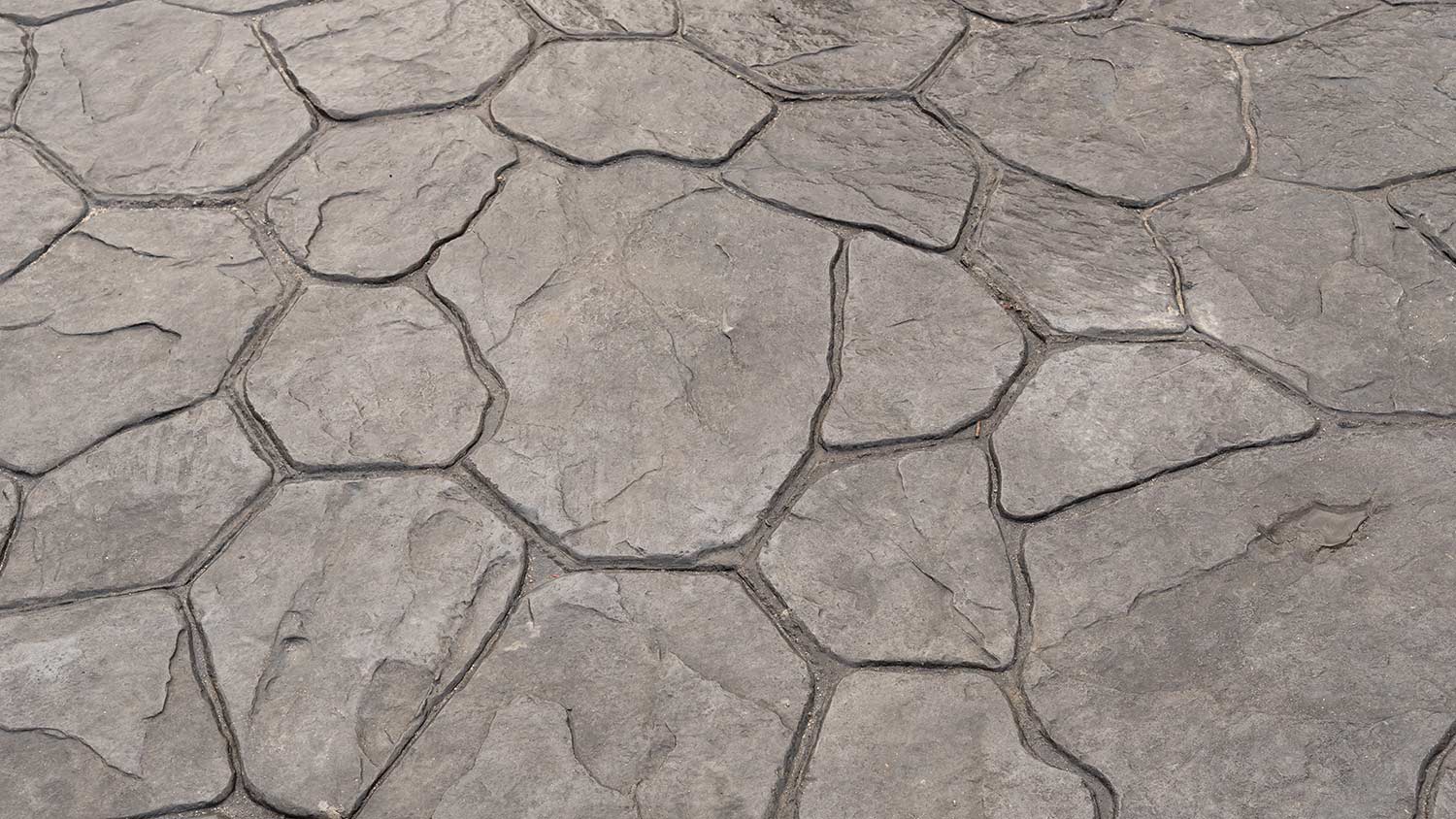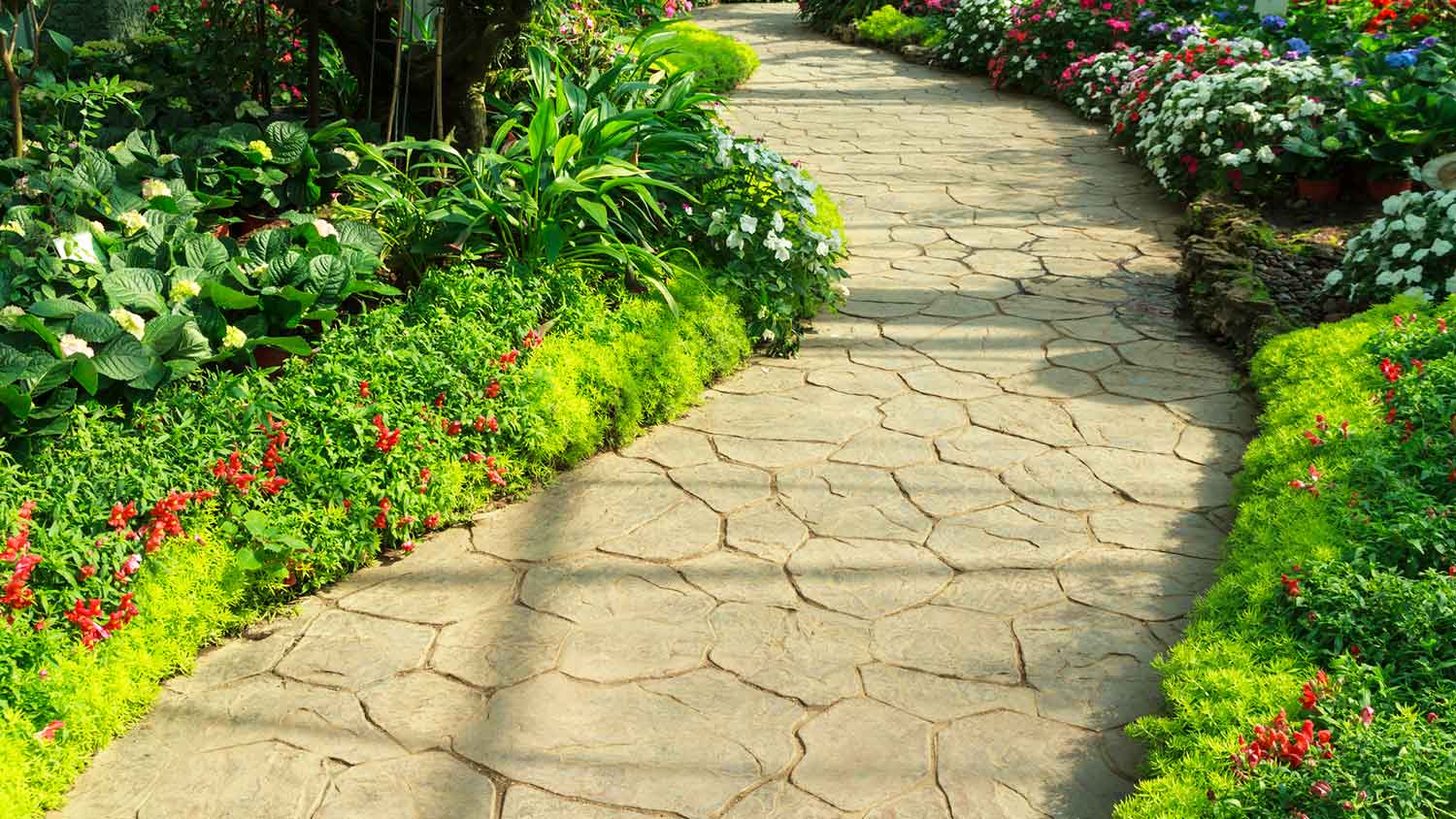
Discover stamped concrete wall cost estimates, including average prices, key cost factors, and tips to help you budget your project with confidence.
Stamped concrete cost averages $5,289, with most homeowners paying between $2,955 to $7,790. Your price depends on project size, design complexity, and location.


The key cost drivers for stamped concrete include the project size, design, and site preparation needs.
Professional concrete layers charge between $5 to $15 per square foot, depending on complexity and region.
If you choose to DIY your stamped concrete, factor tool rental or purchase into your overall cost, adding $500 to $2,000.
Professional installation ensures durability and curb appeal.
This article was created using automation technology and thoroughly fact-checked and edited by an Angi Editor in accordance with our AI policy.
Stamped concrete cost averages $5,289 for a typical project, with most homeowners spending between $2,955 to $7,790. Prices range from $9 to $22 per square foot, depending on design complexity, materials, and labor. Smaller projects can be as little as $1,200, while larger, custom designs can exceed $14,000.
Stamped concrete is a popular choice for enhancing outdoor spaces. Understanding stamped concrete cost helps you budget for patios, driveways, or walkways with lasting curb appeal.
Several factors influence stamped concrete cost beyond just size and style.
Project size is the biggest factor influencing stamped concrete cost. The total square footage directly impacts material and labor expenses. Small patios are more affordable but may still have minimum charges from contractors. Medium walkways and large driveways require more materials and time, increasing the overall price.
Contractors often set minimum project sizes or fees, so very small projects might have a higher per-square-foot cost. Common project sizes include 100 square foot patios, 300 square foot walkways, 500 square foot driveways, and even expansive 1,000 square foot installations.
| Project Type | Size (Sq. Ft.) | Description | Cost Range |
|---|---|---|---|
| Patio | 100 | Small entertainment space | $900–$2,200 |
| Walkway | 300 | Typical garden or entry path | $2,700–$5,300 |
| Driveway | 500 | Medium-sized vehicle drive | $4,500–$11,000 |
| Large patio/driveway | 1,000 | Expansive outdoor living or parking | $9,000–$22,000 |
Stamped concrete comes in a range of styles, each affecting cost. Basic designs use a single pattern and color, while mid-range styles add more color or texture. High-end options include intricate patterns, multiple colors, borders, and custom inlays, all of which require more labor and materials.
Simple patterns like brick or slate are less expensive, while detailed finishes such as cobblestone, wood plank, or custom logos increase costs. More complex patterns and color combinations demand extra time and skill, raising the price per square foot.
Each stamped concrete style has advantages and drawbacks. Basic finishes are easier to maintain and less expensive, but may be less visually striking. Intricate designs offer greater curb appeal and can increase resale value, but may require more frequent maintenance to preserve their appearance.
| Style/Pattern | Description | Average Cost (Per Sq. Ft.) | Pros | Cons |
|---|---|---|---|---|
| Brick | Simple brick stamp, 1 color | $9 | Classic look, easy upkeep | Fewer customization options |
| Slate | Textured stone appearance | $11 | Natural look, good value | Slightly higher maintenance |
| Cobblestone | Detailed, multi-color | $14 | Distinctive, high curb appeal | Higher cost, more upkeep |
| Wood plank | Realistic wood effect | $16 | Warm, unique finish | Needs careful sealing |
| Custom logo/inlay | Unique, personalized design | $18–$22 | One-of-a-kind appearance | Expensive, complex repairs |
Stamped concrete cost varies by region. Local labor rates, material prices, and climate conditions all influence the final price. For example, projects in the Northeast or West Coast often cost more due to higher labor and material expenses, while costs are lower in the Midwest and South.
The area where you install stamped concrete also affects pricing. Driveways may cost more than patios or walkways because of additional prep work, thicker slabs, or access challenges. Tight spaces or sloped yards can increase labor time and complexity.
Stamped concrete is installed by skilled concrete contractors or masons. Labor rates range from $5 to $15 per square foot, depending on complexity and region. Some pros charge minimum fees for small jobs. Larger, more experienced crews can complete projects quickly but may charge more for their expertise.
Permits might be required for driveways, sidewalks, or large patios, depending on local regulations. Fees range from $50 to $300. Inspection and re-inspection fees could add to your total.
Upgrades like decorative borders, custom colors, or embedded designs increase costs. Adding stairs, multi-level surfaces, integrated lighting, or heating elements also raises the price.
Stamped concrete should be resealed every two to three years, costing $200 to $600 each time. Cleaning with gentle products helps preserve the finish. Repairs for cracks, chips, or color loss can cost $300 to $1,000, depending on severity.
Some homeowners consider installing stamped concrete themselves to save money, but there are important trade-offs. DIY material costs for concrete, colorants, and sealers range from $4 to $8 per square foot. Tool rental or purchase, such as stamps and mixers, adds $500 to $2,000. While you can avoid labor charges, mistakes like uneven surfaces or poor stamping can be costly to fix.
DIY requires skill in mixing, pouring, stamping, coloring, and sealing concrete. Safety equipment is a must, and handling heavy materials can be physically demanding. A small patio might take a dedicated DIYer two to three days. Larger or more complex projects can require a week or more. Weather delays and improper curing risk durability.
DIY projects rarely qualify for workmanship warranties. Hiring a local concrete pro ensures quality, longevity, and access to service guarantees. For large, intricate, or high-traffic areas, it’s best to hire a pro.
Knowing when to repair or replace stamped concrete helps you make cost-effective decisions. Minor cracks, spalling, or faded color can often be patched, resealed, or touched up. If the concrete is more than 15 years old, has deep cracks, or shows structural damage, replacement is recommended—especially if repairs exceed half the cost of new installation (the 50% rule).
Repairs are less expensive, costing $300 to $1,500 for patching, resealing, or color restoration. Full replacement, including demolition and new installation, ranges from $4,500 to $15,000, depending on size and complexity. Well-executed repairs can maintain appearance and value, but extensive fixes may not fully restore original looks or strength.
Stamped concrete projects can deliver a solid ROI, especially for patios, driveways, and walkways. Homeowners often recoup 30% to 60% of their investment, depending on location and market trends. Compared to pavers or natural stone, stamped concrete offers a cost-effective way to boost curb appeal.
Upgrading outdoor spaces with stamped concrete increases home value by making areas more attractive and functional. Potential buyers are drawn to stylish, low-maintenance surfaces that enhance the property’s look.
When compared to other exterior improvements, stamped concrete stands out for its durability and visual impact. Consider factors like slip resistance, maintenance needs, and accessibility when planning your project. Custom patterns and color choices let you tailor the look to your home’s style and your family’s needs.
There are several ways to keep your stamped concrete project wallet-friendly without sacrificing quality or design. Taking these steps can help you save money and get the outcome you want:
Opt for standard stamps and single-color finishes to save on labor and materials.
Focus on high-impact areas instead of covering large spaces.
Remove old surfaces or clear the area to cut down on contractor labor.
Solicit bids from several pros to ensure competitive pricing.
Book installation in late fall or early spring for potential savings.
Home is the most important place on earth, which is why Angi has helped more than 150 million homeowners transform their houses into homes they adore. To help homeowners with their next project, Angi provides readers with the most accurate cost data and upholds strict editorial standards. We extensively research project costs to develop the pricing data you see, so you can make the best decisions for you and your home. We rely on reputable sources, including the U.S. Bureau of Labor Statistics, academic journals, market studies, and interviews with industry experts—all to ensure our prices reflect real-world projects.
Want to help us improve our cost data? Send us a recent project quote to [email protected]. Quotes and personal information will not be shared publicly.
From average costs to expert advice, get all the answers you need to get your job done.

Discover stamped concrete wall cost estimates, including average prices, key cost factors, and tips to help you budget your project with confidence.

Here’s what you need to know about stamped concrete overlays, including pros and cons, what they cost, and how they can give your concrete new life.

Stamped concrete maintenance takes a bit more delicacy than other surfaces. Here are seven ways to keep stamped concrete surfaces looking sharp.

A stamped concrete finish can brighten your dull driveway, walkway, or patio. Here are the questions to discuss with a stamped concrete installation pro.

Brushing and stamping are two common concrete finishes. Learn what sets brushed and stamped concrete apart and how to choose between them.

Stamped concrete is an affordable alternative to bricks, pavers, tile, or wood. Learn more about stamped concrete and if it’s right for your project.